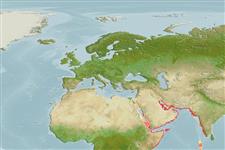Environment: milieu / climate zone / depth range / distribution range
Ecología
marino; rango de profundidad 8 - 10 m (Ref. 10669). Tropical
Distribución
Países | Áreas FAO | Ecosistemas | Ocurrencias, apariciones | Point map | Introducciones | Faunafri
Western Indian Ocean.
Tamaño / Peso / Age
Maturity: Lm ? range ? - ? cm
Max length : 23.8 cm SL macho / no sexado; (Ref. 10669)
Short description
Claves de identificación | Morfología | Morfometría
Radios blandos dorsales (total) : 17 - 18; Radios blandos anales: 48 - 52; Vértebra: 51.
Inshore pelagic (Ref. 68964).
Life cycle and mating behavior
Maturities | Reproducción | Spawnings | Egg(s) | Fecundities | Larva
Randall, J.E., 1994. Ilisha compressa, a new species of clupeid fish from the Persian Gulf. Raff. Bull. Zool. 42(4):893-899. (Ref. 10669)
IUCN Red List Status (Ref. 130435)
Threat to humans
Harmless
Human uses
Herramientas
Special reports
Download XML
Fuentes de Internet
Estimates based on models
Preferred temperature (Ref.
123201): 24.8 - 29, mean 27.3 °C (based on 124 cells).
Phylogenetic diversity index (Ref.
82804): PD
50 = 0.5000 [Uniqueness, from 0.5 = low to 2.0 = high].
Bayesian length-weight: a=0.00871 (0.00397 - 0.01910), b=3.04 (2.87 - 3.21), in cm total length, based on LWR estimates for this Genus-body shape (Ref.
93245).
Nivel trófico (Ref.
69278): 3.5 ±0.5 se; based on size and trophs of closest relatives
Resiliencia (Ref.
120179): Alto, población duplicada en un tiempo mínimo inferior a 15 meses (Preliminary K or Fecundity.).
Fishing Vulnerability (Ref.
59153): Low vulnerability (19 of 100).
